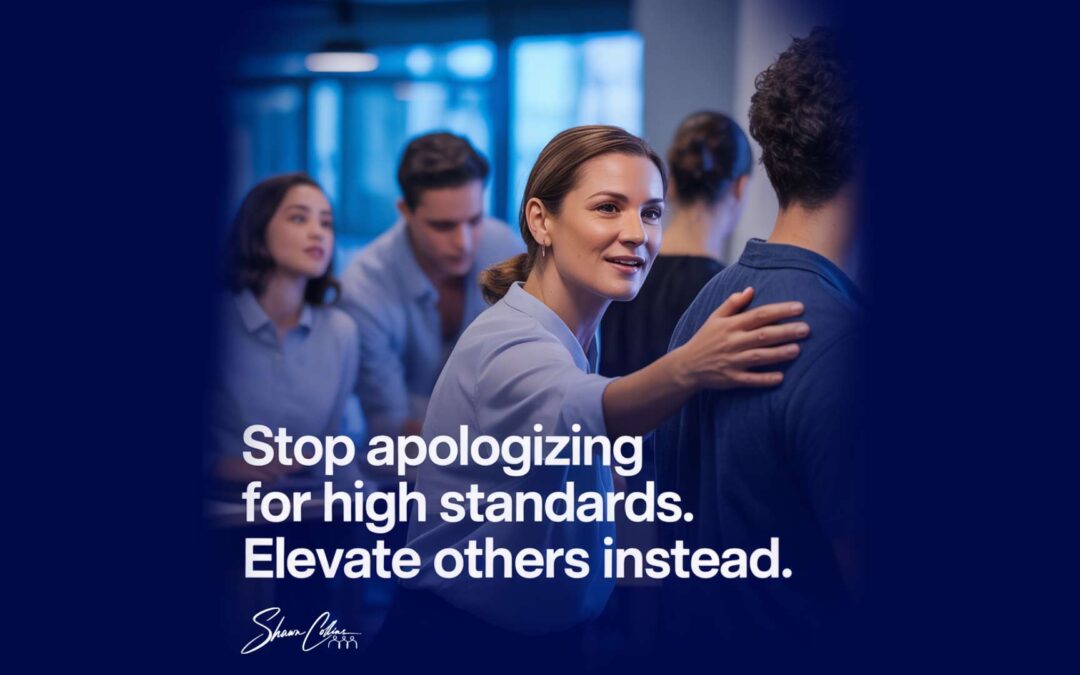High Standards in Leadership: Own Them, Don’t Apologize
In the high-stakes environment of executive leadership, maintaining high standards is not just a goal; it’s a necessity. Yet, many C-suite executives find themselves apologizing for these standards. Why does this happen? Often, it stems from a desire to be liked or an unnecessary fear of pushback. Executives feel compelled to soften their expectations with qualifiers, thinking it will foster a more congenial atmosphere. However, this approach can be counterproductive.
When leaders apologize for their high standards, they unintentionally convey a lack of confidence in their vision and goals. This creates confusion within teams, leading to diminished morale and compromised performance. Your expectations should inspire your team rather than burden them.
Moreover, this habitual apologizing can influence organizational culture, creating an environment where mediocrity may be tolerated. Over time, this undermines the very essence of leadership effectiveness and erodes the company’s competitive edge. High standards should be a badge of honor that elevate the team and drive results, not an excuse for reluctance or hesitation.
As we explore this topic further, it’s imperative to recognize that high standards are not just about demanding excellence; they are about empowering your team to reach it without the burden of unnecessary apologies.
Understanding High Standards in Executive Leadership
High standards in executive leadership are more than just lofty aspirations. They represent a clear vision of what excellence looks like, both for yourself and your organization. At the executive level, these standards encompass everything from operational efficiency to team dynamics, influencing how goals are set and achieved.
What Do High Standards Mean?
High standards signify a commitment to quality and performance. They involve:
- Setting Clear Expectations: You expect more than mediocrity. This means articulating what success looks like down to specific metrics and behaviors.
- Fostering Accountability: You hold yourself and your team accountable for results. This not only drives performance but also instills trust in your leadership.
- Encouraging Continuous Improvement: High standards are not static. You encourage your team to always seek ways to innovate and refine their processes.
The Importance of High Standards
Why are these standards critical to organizational success? Here are a few reasons:
- Drives Performance: When you maintain high expectations, you push your team to perform at their best. This performance leap often translates to better overall results.
- Shapes Company Values: High standards directly shape your company culture. They set a baseline for the behaviors and practices that are celebrated within your organization.
- Improves Engagement: Employees tend to be more engaged when they feel challenged and valued. High standards create an environment that promotes motivation and enthusiasm.
The Impact on Company Values and Outcomes
Incorporating high standards into your leadership approach influences how your organization operates. Your values become clearly defined — a vision that everyone rallies around. This creates a strong sense of identity and purpose, guiding decision-making and fostering loyalty among your workforce.
Ultimately, high standards lead to improved outcomes. This means better financial performance, increased customer satisfaction, and a more robust brand reputation. When your team knows that excellence is expected and that they have the support to achieve it, your organization as a whole benefits.
Recognizing the value of high standards is just the first step. The real challenge is how to uphold them without resorting to apologies, thus ensuring that you not only elevate your leadership but also empower your entire team to strive for greatness.
The Pitfalls of Apologizing for High Standards
Apologizing for high standards seems harmless at first glance, but it can have damaging effects on your leadership effectiveness. Understanding why you might feel the urge to qualify your expectations is crucial for overcoming this tendency.
Fear of Pushback
One primary reason executives apologize for their high standards is the fear of pushback. You might worry that demanding excellence will invite criticism or resistance from your team. This fear can lead you to soften your message, undermining the very standards you’re trying to uphold. By doing this, you not only weaken your authority but also create a culture where mediocrity thrives.
Desire to Be Liked
A deep-rooted desire to be liked often drives leaders to apologize excessively. You may think that by showing vulnerability and a willingness to compromise, you’ll gain favor within your team. However, this approach can backfire. When you prioritize being liked over being respected, you diminish your credibility and the respect your team has for the standards you set. Your team needs to know that you care about their success and the organization’s goals more than you care about approval.
Misinterpretation of Assertive Leadership
Many executives misinterpret assertive leadership as being overly harsh. This misconception can lead to the belief that setting high standards inherently makes you a difficult leader. In reality, assertiveness is about clarity and direction. When you set high standards, you should aim to inspire and motivate, not apologize. Instead of viewing high expectations as a burden, frame them as an opportunity to elevate your team’s performance.
When you apologize for high standards, it sends a message that those standards are negotiable, which can lead to confusion and inconsistency in your team’s performance. Your expectations should serve as a rallying point, not as a burden to bear.
Recognizing these pitfalls is the first step toward reclaiming the power of your leadership. As you shift your mindset and stop apologizing for high standards, you’ll create a more confident and empowered team environment. Next, we’ll explore how to facilitate this critical mindset shift from apology to empowerment.
Shifting Mindsets: From Apologizing to Empowering
To stop apologizing for high standards, you need a fundamental shift in mindset. This isn’t just about adjusting your language; it’s about fundamentally changing how you view leadership and the expectations you set for your team. Embracing high standards as a natural extension of your leadership will not only strengthen your position but also foster a culture of empowerment within your organization.
Embrace Your Standards as a Strength
First, recognize that high standards are a reflection of your commitment to excellence. Instead of apologizing, own these standards confidently. High standards don’t mean you’re demanding the impossible; they’re about setting a clear vision that your team can rally around. This clarity inspires trust, showing your team that you’re serious about helping them grow and succeed.
Shift from Fear to Confidence
Let’s face it: fear of disapproval or backlash can paralyze leaders. But what if you reframed your narrative? Instead of worrying about how your standards might be perceived, focus on how they can inspire your team to excel. A confident leader instills confidence in their team. You’ll not only gain respect but also motivate others to push their limits.
Your clarity in communicating high standards can be a powerful tool. When you articulate your expectations clearly, you provide a roadmap for your team. This eliminates confusion and empowers your employees to take ownership of their performance without feeling burdened by vague demands.
Inspire Through Supportive Leadership
One of the biggest misconceptions is that high standards equate to harshness. You can be demanding while still being supportive. Creating an environment where your team feels valued and understood helps them embrace your expectations without the weight of anxiety. Use regular check-ins, feedback sessions, and constructive discussions to reinforce that your high standards are meant to elevate and empower, not to intimidate.
Establish Clear Expectations
Clear expectations provide a foundation for accountability. When you set high standards, make sure your team understands the ‘why’ behind them. Help them connect the dots: How will meeting these standards benefit them? What impact will it have on the organization? When people see the purpose behind your expectations, they’re more likely to strive for them and feel empowered in the process.
Furthermore, recognize that high standards are not static. Encourage your team to seek continuous improvement. When they know that you expect them to innovate and adapt, they’ll feel motivated to bring their best ideas forward. This proactive approach fosters a culture where excellence is the norm and mediocrity is actively discouraged.
Celebrating Success and Learning from Challenges
As you shift your mindset from apologizing to empowering, celebrate the successes that come from maintaining high standards. Acknowledge individual and team achievements openly to reinforce that excellence is recognized and valued. This recognition not only boosts morale but also sets the tone for what the organization values: hard work, dedication, and a commitment to excellence.
When things don’t go as planned, view challenges as learning opportunities. Discuss what can be improved and how to overcome obstacles together. This approach not only helps maintain high standards but also fosters resilience within your team, equipping them with tools to meet future challenges head-on.
By embracing this mindset shift, you can transform how others perceive high standards. When you stop apologizing and start empowering, you position yourself and your team for success while creating a work environment where excellence is the expectation, not the exception.
Practical Strategies to Elevate Teams While Maintaining High Standards
Creating a workplace where high standards thrive requires practical strategies that support your vision while empowering your team. Here are five actionable approaches to help you elevate your team without compromising your expectations.
- Foster Transparent Communication: Start with open lines of communication. Be clear about your high standards and the reasoning behind them. When your team understands why these expectations are in place, they’re more likely to embrace them. Consider implementing regular updates through team meetings or newsletters that reaffirm your vision and clarify expectations.
- Cultivate Psychological Safety: To empower your team, you need to create an environment where they feel safe to express their thoughts and take risks. Encourage team members to voice their concerns or suggestions without fear of judgment. This psychological safety fosters creativity, allowing individuals to contribute their best work while meeting high standards.
- Invest in Coaching and Mentoring: Development is key. Offer coaching and mentoring to help your team meet and exceed expectations. This can take the form of one-on-one sessions or group workshops focused on skills relevant to their roles. By investing in their growth, you demonstrate your commitment to their success while reinforcing your high standards.
- Recognize and Celebrate Improvements: Don’t only focus on outcomes; recognize the steps taken to achieve them. When team members show initiative or make improvements, celebrate these milestones openly. This recognition not only boosts morale but signals that hard work and striving for excellence do not go unnoticed.
- Foster Accountability: Accountability is crucial for maintaining high standards. Set up systems that ensure everyone knows their roles and responsibilities. Regularly review progress against these responsibilities and provide constructive feedback. When team members know they’re accountable, they take ownership of their contributions, creating a culture where excellence is a shared goal.
Implementing these strategies will empower your team to meet high standards with happiness and confidence. By integrating transparent communication, fostering psychological safety, investing in development, recognizing improvements, and promoting accountability, you build a culture that not only accepts but thrives on excellence. This approach will elevate both individual performance and organizational outcomes.
Case Studies and Real-World Examples
To truly grasp the impact of unapologetic high standards in leadership, it’s helpful to look at real-world examples. Several C-suite leaders and organizations in the U.S. have effectively embraced high standards, resulting in empowered teams and remarkable achievements.
Satya Nadella at Microsoft
Since taking over as CEO, Satya Nadella has redefined Microsoft’s corporate culture. He has set high expectations not just for product performance, but also for innovation and collaboration. Nadella’s approach centers on a growth mindset — encouraging employees to learn from failures. Instead of softening his expectations, he has elevated standards across the board, emphasizing that continuous learning and improvement are the norm.
This shift has led to significant increases in employee engagement and satisfaction. Microsoft’s stock value and market position have soared, illustrating that high standards, when paired with supportive leadership, can lead to exceptional outcomes.
Mary Barra at General Motors
Mary Barra, as CEO of General Motors, has explicitly emphasized the importance of high standards in safety and innovation. Her insistence on quality remains unwavering; she understands that setting clear expectations is crucial for maintaining trust with both consumers and stakeholders. Through rigorous testing and an unyielding focus on safety, Barra has reinforced GM’s commitment to excellence.
This unapologetic stance not only enhances the company’s reputation but also motivates employees to take pride in their work. Under her leadership, GM has shifted towards electric vehicles, demonstrating that maintaining high standards can also push innovation forward.
Tim Cook at Apple
Tim Cook exemplifies a leadership style that firmly embraces high standards. By prioritizing product excellence and customer satisfaction, he has kept Apple at the forefront of technology. Cook openly sets rigorous expectations for product development, insisting that every detail counts. This clarity drives teams to produce top-tier products that consistently resonate with consumers.
The results speak for themselves: Apple’s brand loyalty remains extremely high, with users who trust in the quality of every new release. Cook’s approach showcases how setting high standards can motivate teams to push boundaries and achieve remarkable results.
Rosalind Brewer at Starbucks
As the CEO of Starbucks, Rosalind Brewer has adopted a leadership approach that integrates high standards with a focus on inclusivity and employee engagement. She believes in elevating the standards of customer service while ensuring that employees feel empowered and valued. Brewer has fostered a culture where high expectations are the standard, encouraging teams to innovate in service delivery.
This commitment has strengthened Starbucks’ brand and deepened customer loyalty. Brewer’s success shows that setting high standards does not diminish team morale; rather, it can enhance it when coupled with genuine leadership.
Examples from Smaller Organizations
It’s not only large corporations that exemplify high standards. Numerous small and medium-sized enterprises, like Basecamp, uphold high expectations without apology. They focus on quality over quantity, ensuring that projects meet rigorous benchmarks. This clarity and commitment lead to high employee satisfaction and customer loyalty, proving that high standards can be effectively maintained regardless of company size.
These case studies underline a crucial lesson: unapologetic high standards not only propel organizations forward but also inspire teams to achieve more than they thought possible. By looking to these leaders, you can find both inspiration and a roadmap for cultivating a culture of excellence in your own organization. The journey of elevating others begins with your commitment to unwavering standards.
Measuring the Impact: How Maintaining High Standards Without Apology Drives Business Results
As a C-suite executive, understanding the tangible effects of maintaining high standards is critical. Your leadership approach directly correlates with various key performance indicators (KPIs) that reflect improvements in your organization. By confidently holding high standards, you create an environment conducive to performance, engagement, and innovation.
Key Metrics to Track
Here’s a breakdown of essential metrics that illustrate the impact of your high standards:
- Employee Engagement Scores: Engagement is a leading indicator of productivity. When you set and maintain high standards, team members feel challenged and valued. Regular surveys can provide insights into how employees perceive your expectations and whether they feel supported in meeting them.
- Retention Rates: High turnover can indicate a lack of commitment to excellence. If your environment promotes accountability and recognizes efforts to achieve high standards, you are likely to see improved retention. Track this over time to gauge the impact of your leadership style.
- Performance Metrics: Metrics such as sales performance, project completion rates, and quality assessments provide direct insight into how your standards influence outcomes. Analyze performance data before and after you implement a consistent high standard approach.
- Innovation Rates: High standards often foster a culture of innovation. Track the number of new ideas, products, or processes introduced by your team. This metric can demonstrate how a commitment to excellence encourages creative thinking.
- Customer Satisfaction Scores: End-user experience is a reflection of internal standards. Regularly measure customer satisfaction and feedback. When your team operates under high expectations, clients often notice improved service quality and responsiveness.
Linking High Standards to Business Outcomes
Maintaining high standards isn’t just about holding your team accountable; it’s about driving concrete business results that support long-term goals. Here’s how these metrics align with broader organizational outcomes:
- Increased Productivity: A team that knows what is expected of them and feels empowered by high standards will naturally work harder. As employee engagement rises, so does productivity, which can lead to superior financial performance.
- Enhanced Brand Reputation: Organizations that consistently produce high-quality work gain credibility in their industry. This reputation can significantly impact client acquisition and retention.
- Cost Savings: When teams embrace high standards, they are less likely to revisit projects due to errors or poor quality, ultimately saving time and resources.
- Improved Market Share: By innovating and enhancing products or services through a commitment to high standards, your organization can capture additional market share and respond effectively to consumer demands.
Real-Life Examples
Many organizations that uphold high standards demonstrate clear correlations between leadership practices and performance outcomes. For instance, companies like Microsoft and General Motors have successfully improved their performance metrics and market positions by insisting upon stringent quality and innovation standards. When leaders confidently communicate high expectations, they cultivate an organizational culture that thrives on ambition, resulting in significant business advantages.
Ultimately, measuring the impact of high standards goes beyond tracking numbers. It’s about recognizing how they influence your workforce’s morale, satisfaction, and drive. When you commit to maintaining high standards without apology, you set the stage for elevated organizational performance and a workforce eager to excel.
Owning high standards is not a weakness; it’s a testament to your commitment to excellence and your team’s potential. It’s time to shift the perspective from defending your expectations to leveraging them as a source of power. When you stop apologizing for having high standards, you not only elevate your own leadership but also inspire those around you to strive for excellence as a shared goal.
High standards can pave the way for growth and innovation. Your team will feel emboldened to take risks, suggest ideas, and push boundaries when they know you believe in them and expect them to deliver excellence. You create a culture where striving for greatness becomes second nature, and this transformation begins with you.
This is your call to action: commit to owning your standards and making them a bedrock of your organizational culture. Start viewing these expectations as essential tools for development rather than hurdles to appease. Remember, when you elevate rather than apologize, you pave the way for a more engaged, motivated, and high-performing team.
High standards deserve to be celebrated and embraced. Embrace the fact that you demand greatness because you believe in the capabilities of your team. By fostering an environment where excellence is the norm, you challenge your employees to reach their peak performance. When they do, their achievements will reflect on the entire organization. This unity in purpose and performance not only enhances your brand but also solidifies your legacy as a leader who champions growth and supports every individual in their journey toward success.
So, take a deep breath and let go of those unnecessary apologies. It’s time to lead with conviction.




